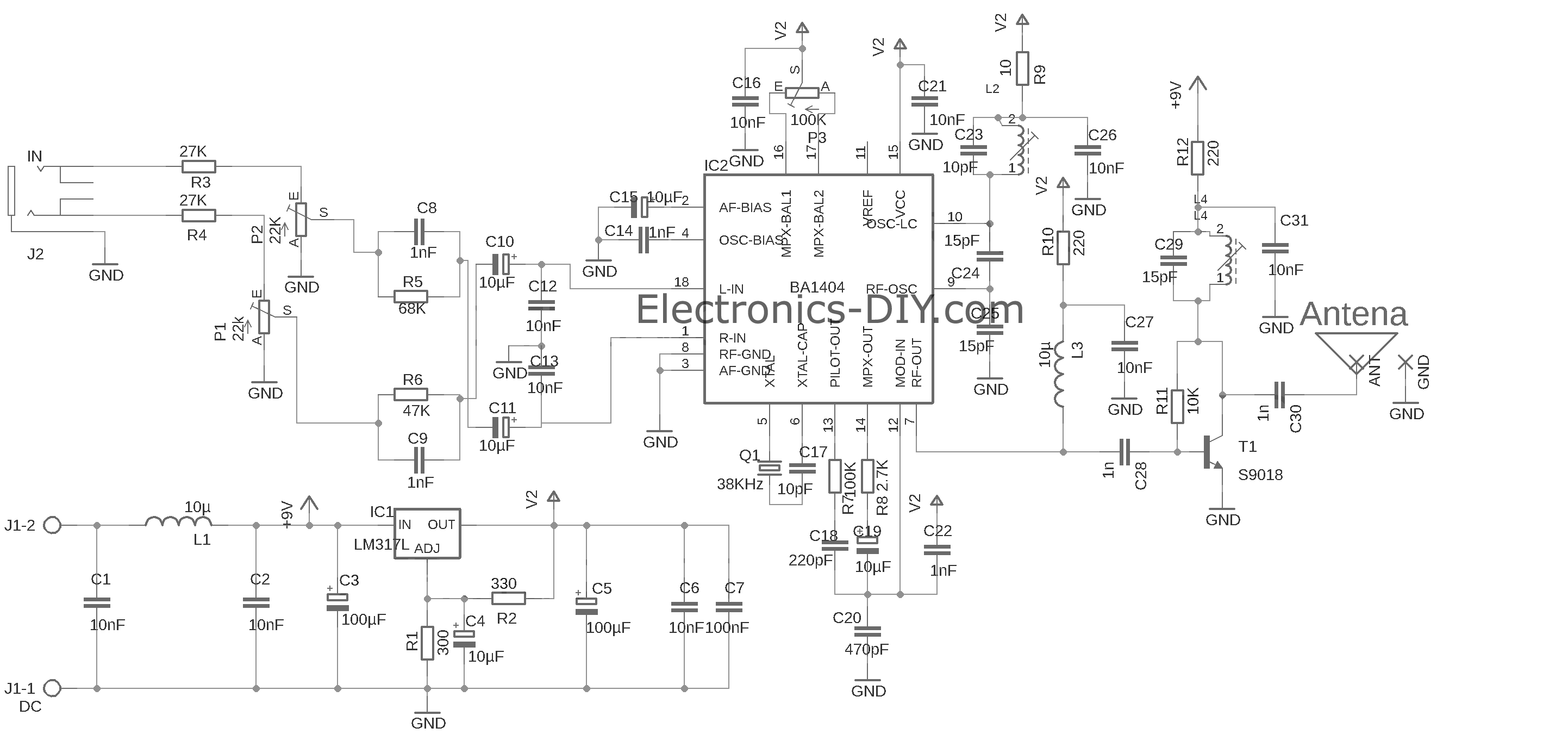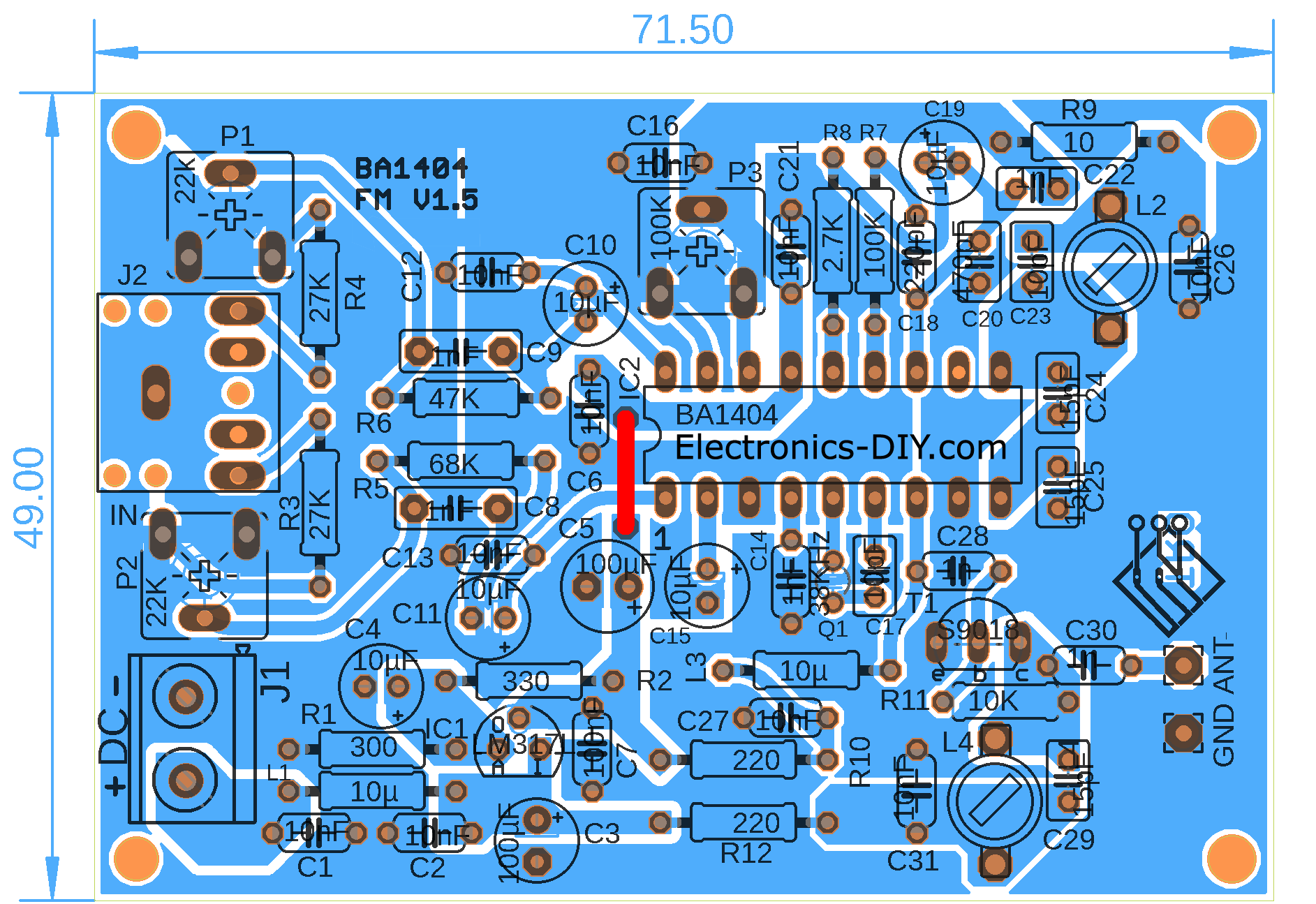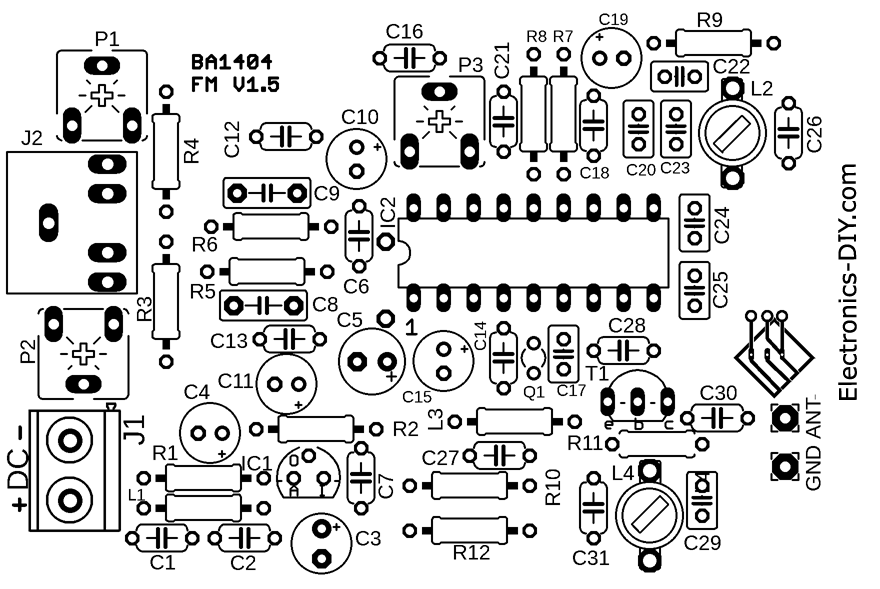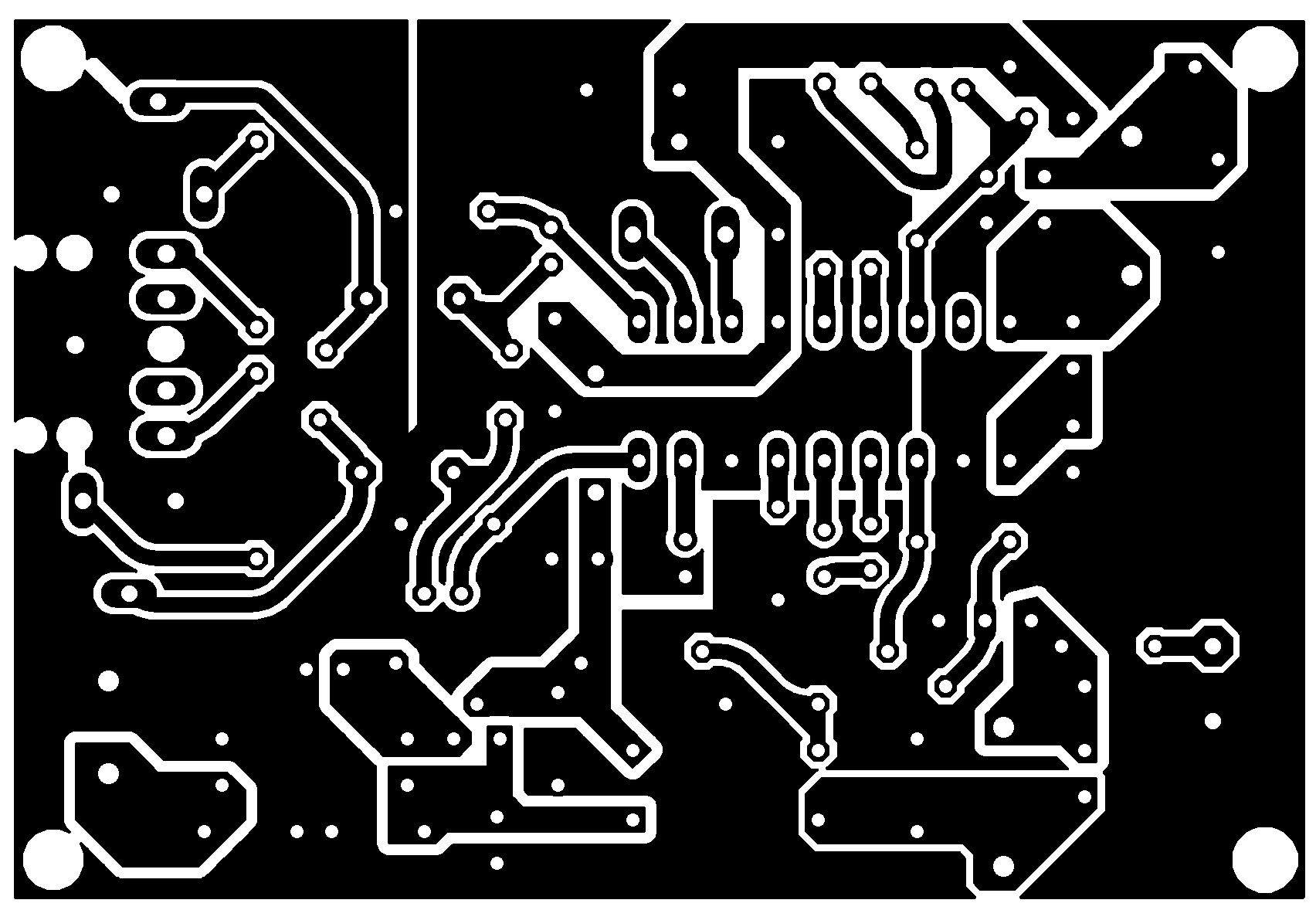| |
BA1404 Stereo FM Transmitter with Booster |
|
Build your own fairly simple high quality stereo FM transmitter circuit as shown in the photo. The circuit is based on the BA1404 chip from ROHM Semiconductors and S9018 amplifier for extending tansmitter's range. BA1404 is a monolithic FM stereo modulator that has built in stereo modulator, FM modulator, RF amplifier circuits. The FM modulator can be operated from 76 to 108MHz and the power supply for the circuit can be anything between 6 to 12 volts.

About the FM transmitter circuit with BA1404
The circuit formed by C1, L1, C2, C3 is a filter (optional) for transients that may come from our power supply. Anyway, prefer to use power supplies with good filtering.
R3/P2 and R4/P1 form the limiting circuit for the audio signal level for the integrated circuit. According to the datasheet, this value should be 0.5V (500mV), so adjust the trimpot so that the audio signal is clear when transmitting. You may need to change the 27K resistors at the input.
C8/R5 and C9/R6 form the pre-emphasis circuit, to calculate the value use the following formula Ct = R × C.
Capacitors C10 and C11 with the IC input resistance (impedance) form a high pass filter, allowing the signal to pass above 30Hz. The input impedance is 540 Ohm, for 30Hz frequency, the calculator value for the capacitor is about 10uF.
Capacitors C12 and C13 form a low-pass filter, for FM 15KHz, by calculations we arrive at about 20nF. You can use values of 18nF for the tolerance of the components, thus ensuring that the 15KHz range is passed.
C15 is the bias capacitor of the audio stage signal and C14 the bias capacitor of the 38KHz oscillator, P3 forms the balance circuit and the multiplexed signal.
The audio signal from each channel is amplified separately by 37dB and the signal applied to the multiplexer, the crystal oscillator connected from on pins 5 and 6, create a 38Khz subcarrier and 19KhZ pilot signal with the same phase, but with 1/2 cycle delay. The audio signal and the 38Khz carrier are balanced and modulated in the multiplexer. Thus we will have at the output the L + R signal, the 38Khz subcarrier and two carriers, the L-R. The multiplexed signal is output at pin 14. The 19KHz pilot signal is generated by dividing the crystal frequency by 2, this signal is output on pin 13.
The components connected to pins 13 and 14 mixes the signal, generating the MPX composite signal delivered to pin 12.
The integrated circuit has internally a special transistor to work with high frequencies, forming a Collpits oscillator, the components connected between pins 9 and 10 complete the FM modulator circuit. With the values in the circuit, we have covered the FM range. You may need to change capacitor values to achieve the result. Use ceramic capacitors of type NP0, in order to prevent the frequency from varying due to temperature change.
The FM signal is delivered on pin 7, you may need to change the value of C31 to get better power, values between 4.7pF and 15pF can be used.
The RF coil is usually a critical component in FM transmitter assemblies, the ideal coil for this circuit is a 3.5 turn ferrite core found in FM radios. Below you can see the model of this coil.
However, if you can’t find such a coil, you can make one yourself by winding 4 coils of 22 AWG enameled copper wire on a 5 mm diameter ferrite core. To adjust the operating frequency of the stereo transmitter, use a plastic key to adjust and find an fm-free range.
About Pre-emphasis and De-emphasis
Random noise has a triangular spectral distribution in an FM system, with the effect that the noise occurs predominantly at the higher audio frequencies in the baseband. This can be compensated for, to some extent, by increasing the high frequencies before transmission and reducing them by a corresponding amount at the receiver. Reducing the high audio frequencies at the receiver also reduces the high-frequency noise. These processes of increasing and reducing certain frequencies are known as pre-emphasis and non-emphasis reduction, respectively.
The amount of pre-emphasis and non-emphasis used is defined by the time constant of a simple RC filter circuit. In most parts of the world, a time constant of 50 µs is used. In the Americas and South Korea, 75 µs is used. This applies to both mono and stereo transmissions. For stereo, pre-emphasis is applied to the left and right channels before multiplexing.
The use of pre-emphasis becomes a problem because many forms of contemporary music contain more high-frequency energy than the styles of music that were prevalent at the birth of FM broadcasting. Pre-emphasis of these high-frequency sounds would cause excessive deviation of the FM carrier. Modulation control (limiter) devices are used to prevent this. Systems more modern than FM transmission tend to use program-dependent variable pre-emphasis; for example, dbx in the BTSC TV sound system, or none.
The 38KHz crystal guarantees stereo transmission, in case you can’t find this component for your circuit assembly, you will get a high quality mono transmission.
The high-frequency signal follows from pin 7 to transistor T1 to guarantee a longer transmission distance, capacitor C9 couples the antenna that can be a telescopic or a piece of hard-wire.
The power supply should be a 6 to 12V source or battery, the higher voltage will feed the power transistor, but for the BA 1404 integrated circuit it will be necessary below 3 Volts, or it may burn out. To power the integrated circuit we use an adjustable voltage regulator IC LM317L set to about 2.4V. If you prefer, you can change the resistors to have a higher voltage. For example, by changing R1 to 330 ohms, we get 2.5V at the output. If you prefer, use this calculator for LM317.
When assembling this circuit, make sure all components are positioned in the correct place and only then connect the battery, then connect an audio source such as a cell phone, for example, and with a nearby FM receiver tuned to a free FM frequency, adjust the coil, using a plastic or wooden “key”, until you hear the signal on the radio. If you can’t adjust it, try other values for C13, and then retune the settings.
If you cannot tune in the FM range 88 to 108 MHZ, try changing the value of the tuning capacitor. In the last case the coil can be 4 coils of enameled wire with an air core and the capacitor a variable capacitor from 6 to 30pF. The reason for not using an air-core coil is that with changes in ambient temperature, there is a variation in the size of this coil that will interfere with frequency stability, which is not ideal in good quality FM generators.
Suggested PCB mounting stereo FM transmitter with integrated BA 1404 and crystal 38KHZ.
Parts
Part Value Description Quantity
Resistors 1/4W
R1 300 Orange, black, brown, gold 1
R2 330 Orange, orange, brown, gold 1
R3, R4 27K Red, violet, orange, gold 2
R5 68K Blue, gray, orange, gold 1
R6 47K Yellow, violet, orange, gold 1
R7 100K Brown, black, yellow, gold 1
R8 2.7K Red, violet, red, gold 1
R9 10 Brown, black, black, gold 1
R10, R12 220 Red, red, brown, gold 2
R11 10K Red, red, brown, gold 1
Capacitors
C1, C2, C6, C12, C13, C16, C21, C26, C27, C31 10nF (103) Ceramic Capacitor 10
C3 100µF/25V Electrolytic Capacitor 1
C5 100µF/12V Electrolytic Capacitor 1
C4, C10, C11, C15, C19 10µF/12V Electrolytic Capacitor 5
C7 100nF (104) Ceramic Capacitor 1
C8, C9, C14, C22, C28, C30 1nF (102) Ceramic Capacitor 4
C17, C23 10pF (10p) Ceramic Capacitor NP0 2
C18 220pF (221) Ceramic Capacitor 1
C20 470pF (471) Ceramic Capacitor 1
C24, C25, C29 15pF (15p) Ceramic Capacitor NP0 3
Semiconductors
IC1 LM317L Adjustable voltage regulator integrated circuit. 1
IC2 BA1404 FM transmitter integrated circuit 1
T1 SS9018 (S9018) or equivalent NPN transistor for RF 1
Q1 38KHz Quartz crystal 1
Miscellaneous
J1 DC (Power Supply) Terminal block 2 pin 5.08 mm 1
J2 IN (audio input) Stereo P2 connector. 1
L1, L3 10µH Brown, black, black, silver 2
L2, L4 Adjustable coil Adjustable coil, 3.5 turns ferrite core. 1
P1, P2 22K (223) Trimpot 2
P3 100K (104) Trimpot 1
Solder, Wires, PCB, case, font, etc.



Related Links
Downloads
BA1404 Stereo FM Transmitter with Booster - Link
|
|
|
| |
Accurate LC Meter
Build your own Accurate LC Meter (Capacitance Inductance Meter) and start making your own coils and inductors. This LC Meter allows to measure incredibly small inductances making it perfect tool for making all types of RF coils and inductors. LC Meter can measure inductances starting from 10nH - 1000nH, 1uH - 1000uH, 1mH - 100mH and capacitances from 0.1pF up to 900nF. The circuit includes an auto ranging as well as reset switch and produces very accurate and stable readings. |
|
PIC Volt Ampere Meter
Volt Ampere Meter measures voltage of 0-70V or 0-500V with 100mV resolution and current consumption 0-10A or more with 10mA resolution. The meter is a perfect addition to any power supply, battery chargers and other electronic projects where voltage and current must be monitored. The meter uses PIC16F876A microcontroller with 16x2 backlighted LCD. |
|
|
|
60MHz Frequency Meter / Counter
Frequency Meter / Counter measures frequency from 10Hz to 60MHz with 10Hz resolution. It is a very useful bench test equipment for testing and finding out the frequency of various devices with unknown frequency such as oscillators, radio receivers, transmitters, function generators, crystals, etc. |
|
1Hz - 2MHz XR2206 Function Generator
1Hz - 2MHz XR2206 Function Generator produces high quality sine, square and triangle waveforms of high-stability and accuracy. The output waveforms can be both amplitude and frequency modulated. Output of 1Hz - 2MHz XR2206 Function Generator can be connected directly to 60MHz Counter for setting precise frequency output. |
|
|
|
BA1404 HI-FI Stereo FM Transmitter
Be "On Air" with your own radio station! BA1404 HI-FI Stereo FM Transmitter broadcasts high quality stereo signal in 88MHz - 108MHz FM band. It can be connected to any type of stereo audio source such as iPod, Computer, Laptop, CD Player, Walkman, Television, Satellite Receiver, Tape Deck or other stereo system to transmit stereo sound with excellent clarity throughout your home, office, yard or camp ground. |
|
USB IO Board
USB IO Board is a tiny spectacular little development board / parallel port replacement featuring PIC18F2455/PIC18F2550 microcontroller. USB IO Board is compatible with Windows / Mac OSX / Linux computers. When attached to Windows IO board will show up as RS232 COM port. You can control 16 individual microcontroller I/O pins by sending simple serial commands. USB IO Board is self-powered by USB port and can provide up to 500mA for electronic projects. USB IO Board is breadboard compatible. |
|
|
|
|
ESR Meter / Capacitance / Inductance / Transistor Tester Kit
ESR Meter kit is an amazing multimeter that measures ESR values, capacitance (100pF - 20,000uF), inductance, resistance (0.1 Ohm - 20 MOhm), tests many different types of transistors such as NPN, PNP, FETs, MOSFETs, Thyristors, SCRs, Triacs and many types of diodes. It also analyzes transistor's characteristics such as voltage and gain. It is an irreplaceable tool for troubleshooting and repairing electronic equipment by determining performance and health of electrolytic capacitors. Unlike other ESR Meters that only measure ESR value this one measures capacitor's ESR value as well as its capacitance all at the same time. |
|
Audiophile Headphone Amplifier Kit
Audiophile headphone amplifier kit includes high quality audio grade components such as Burr Brown OPA2134 opamp, ALPS volume control potentiometer, Ti TLE2426 rail splitter, Ultra-Low ESR 220uF/25V Panasonic FM filtering capacitors, High quality WIMA input and decoupling capacitors and Vishay Dale resistors. 8-DIP machined IC socket allows to swap OPA2134 with many other dual opamp chips such as OPA2132, OPA2227, OPA2228, dual OPA132, OPA627, etc. Headphone amplifier is small enough to fit in Altoids tin box, and thanks to low power consumption may be supplied from a single 9V battery. |
|
|
|
|
|
Arduino Prototype Kit
Arduino Prototype is a spectacular development board fully compatible with Arduino Pro. It's breadboard compatible so it can be plugged into a breadboard for quick prototyping, and it has VCC & GND power pins available on both sides of PCB. It's small, power efficient, yet customizable through onboard 2 x 7 perfboard that can be used for connecting various sensors and connectors. Arduino Prototype uses all standard through-hole components for easy construction, two of which are hidden underneath IC socket. Board features 28-PIN DIP IC socket, user replaceable ATmega328 microcontroller flashed with Arduino bootloader, 16MHz crystal resonator and a reset switch. It has 14 digital input/output pins (0-13) of which 6 can be used as PWM outputs and 6 analog inputs (A0-A5). Arduino sketches are uploaded through any USB-Serial adapter connected to 6-PIN ICSP female header. Board is supplied by 2-5V voltage and may be powered by a battery such as Lithium Ion cell, two AA cells, external power supply or USB power adapter. |
|
200m 4-Channel 433MHz Wireless RF Remote Control
Having the ability to control various appliances inside or outside of your house wirelessly is a huge convenience, and can make your life much easier and fun. RF remote control provides long range of up to 200m / 650ft and can find many uses for controlling different devices, and it works even through the walls. You can control lights, fans, AC system, computer, printer, amplifier, robots, garage door, security systems, motor-driven curtains, motorized window blinds, door locks, sprinklers, motorized projection screens and anything else you can think of. |
|
|
|